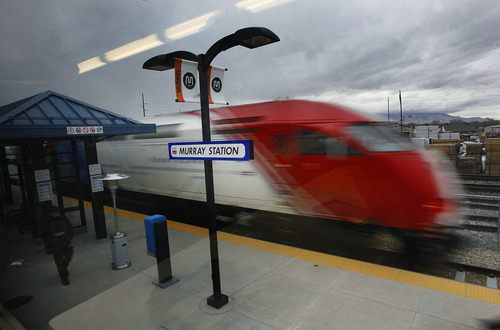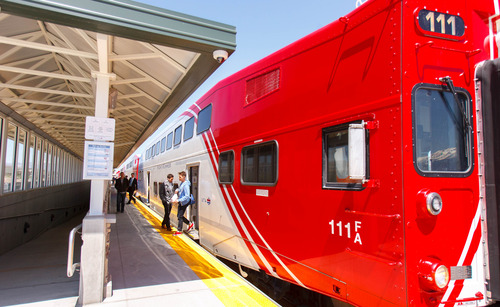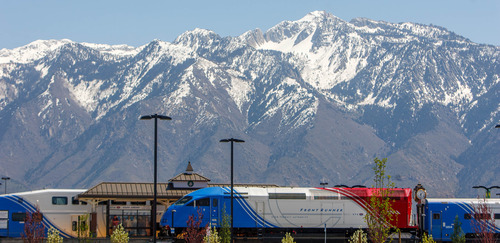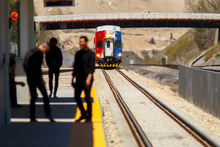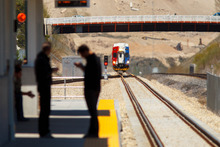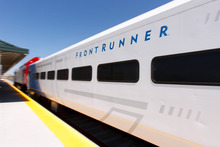This is an archived article that was published on sltrib.com in 2013, and information in the article may be outdated. It is provided only for personal research purposes and may not be reprinted.
As the FrontRunner commuter train system just passed its fifth birthday, its popularity may finally be picking up speed after chugging along for years without growth.
Utah Transit Authority planners originally projected that the oldest section of the line between Ogden and Salt Lake City would have 5,900 weekday riders at its opening five years ago, said UTA spokesman Remi Barron.
But last year, it averaged 5,821 riders — or 79 fewer per day than UTA had hoped to have back when that route opened, showing ridership since then has been essentially flat.
Barron says ridership on that north section had some spikes when high gas prices led people to abandon cars and some dips when the recession destroyed jobs of some commuters.
But he says ridership has risen steadily since December, when FrontRunner doubled the length of its line by adding an extension between Salt Lake City and Provo.
UTA projected an average of 6,800 weekday riders on that southern section at opening. Added to the 5,900 originally projected at the opening of the north section, the combined projected ridership was 12,700 per weekday.
Ridership averaged 13,469 in March, or 769 above projections, during the last full month for which such numbers are available.
"The combined line makes it more of a complete service," and that may be why ridership is rising, Barron said. "You can now get on in Clearfield and it can take you to Provo, where before they couldn't do that. ... With the complete line, we are expecting an upward trend" to continue.
Also helping, he says, is the opening last month of the airport TRAX line — which connects directly to FrontRunner at its North Temple Station. "That brings into play a whole other group of riders," Barron said.
But acknowledgment that FrontRunner ridership essentially had been flat long-term or under projections concerns activists such as Claire Geddes, a vocal critic of UTA. She said a legislative audit last year warned that ridership projections may be overly optimistic and could lead to deeper debt by not attracting as much from fares as planned.
"When I read these audits, they tell me a different story than what I hear from UTA," she said. And when the agency acknowledges flat growth below projections, "something is wrong with this picture. The public should be skeptical of anything we hear."
But as FrontRunner celebrates its fifth birthday, several riders give reasons why they choose it — which UTA officials say show why they expect others to follow suit and help ridership continue to grow.
"My car broke down last month, so I tried it," says Wendy Johnson, who lives in Clearfield and works in Salt Lake City, as she waited for a train. "I like it much better than driving. I can use my [commuting] time doing other things and I don't have to pay for parking." So she continues to ride it.
"The price was about the same as driving and parking," said Orem resident Larry Goff, who just took his first ride on FrontRunner this week with his wife, Pat, to visit the LDS Family History Library in Salt Lake City. "It was very nice," Pat Goff said, "and a lot easier on the nerves" than driving.
"I can work on the train and not worry about traffic," said Dan Hixson. The Payson resident says he misses an express bus that he used to take instead of the train, "but the commuting time is about the same," and he noted costs are a little better than driving for him.
UTA says that in FrontRunner's five years, it has provided more than 9 million total trips, and its older north section has taken 178 million miles of auto traffic off the road.
"FrontRunner also helps stimulate the economy by making areas of the Wasatch Front more accessible to the public," UTA General Manager Michael Allegra said. " It has helped stimulate billions in development activities along its routes. We provide a return on investment."
The northern part of the FrontRunner line cost $612 million, and the just-completed southern section cost $874 million.
UTA plans to eventually stretch FrontRunner as far north as Brigham City and as far south as Payson. It is currently studying costs and demands of expanding FrontRunner.
"There's great work and great momentum going on," Allegra said. "I'm excited about what the future holds for us."
FrontRunner
Opened April 26, 2008.
Cost of north line between Salt Lake City and Pleasant View: $612 million.
Cost of just-completed line from Salt Lake City to Provo: $874 million.
Provided 9 million trips in five years.
Removed 178 million miles of auto traffic since operations began.
Line is now 89 miles long. Trains travel up to 79 mph.
UTA is considering expanding system to Payson in the south and Brigham City in the north.
Source: Utah Transit Authority


